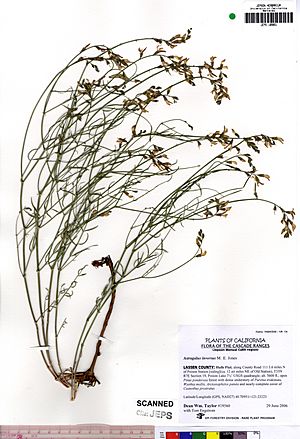Susanville milkvetch facts for kids
Quick facts for kids Astragalus inversus |
|
|---|---|
 |
|
| Scientific classification |
The Susanville Milkvetch (scientific name: Astragalus inversus) is a special type of plant. It belongs to a group of plants called milkvetch.
This plant is found only in a small area in the northeastern part of California. It grows in places that are between 900 and 1,980 meters (about 2,950 to 6,500 feet) high. You can find it in the southern Cascade Range and in the Yellow pine forests. It also grows in dry areas of the Great Basin called Sagebrush scrub.
Contents
What the Susanville Milkvetch Looks Like
The Susanville Milkvetch is a plant that lives for many years. It has thin, wire-like stems that are mostly without leaves. These stems can grow from 20 to 50 centimeters (about 8 to 20 inches) long. They can stand straight up or spread out in a clump.
Leaves and Flowers
The leaves of this plant can be up to 12 centimeters (about 5 inches) long. They are made of a few small, narrow leaflets that are spaced far apart.
The plant's flowers grow in a loose group called an inflorescence. There are usually 5 to 12 flowers in each group. They are pale to reddish-pink, and sometimes have a yellow tint. Each flower is about one centimeter (less than half an inch) long.
Fruit and Seeds
After the flowers, the plant produces fruit. This fruit is a hanging pod called a legume. The pods are 2 to 3.5 centimeters (about 0.8 to 1.4 inches) long. They are narrow and flat. When they dry, they become hairy and feel like paper. Inside these pods are the seeds of the plant.
Images for kids


